Messier Monday: A Spectacular Solstice Spiral, M91
On the shortest night of the year, a galactic giant — the faintest Messier object of all — towers overhead.
“It suddenly struck me that that tiny pea, pretty and blue, was the Earth. I put up my thumb and shut one eye, and my thumb blotted out the planet Earth. I didn’t feel like a giant. I felt very, very small.” –Neil Armstrong
The shortest night of the year comes during the summer solstice, giving us the fewest hours of darkness compared to any other time. But with the Moon having passed its full phase, even just recently, the darkness we do get once the Sun goes down allows for a fantastic view of the deepest of deep-sky objects: the distant galaxies and the faint, diffuse nebulae. Of all the Messier objects, these are the ones most susceptible to being washed out by light pollution.
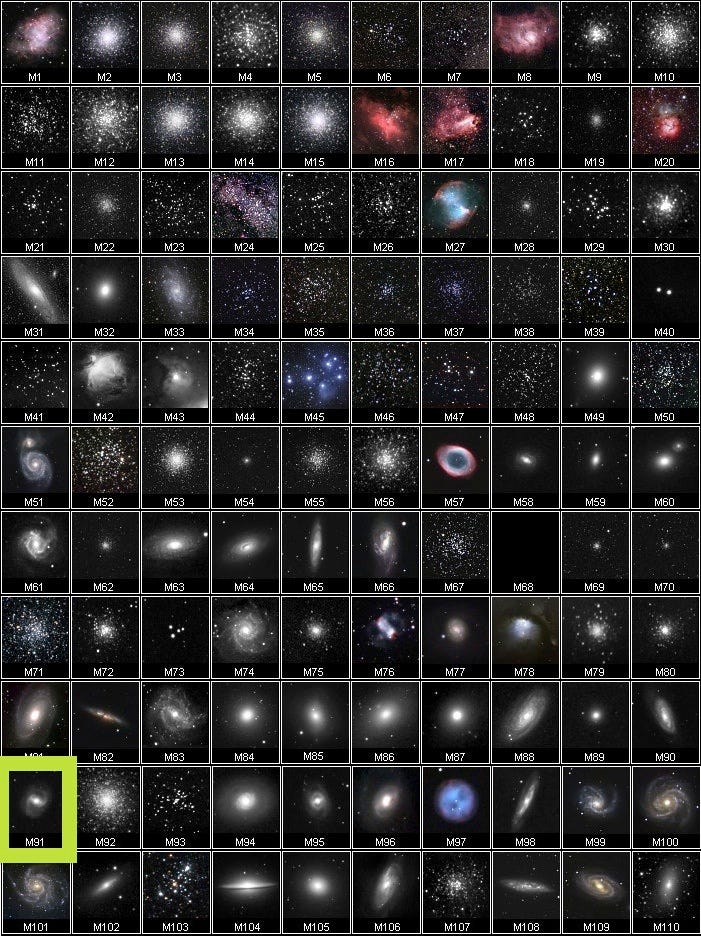
But once the Sun sets and before the Moon comes up, the mid-June skies provide one of the best opportunities for peering deep inside the Virgo cluster of galaxies: the closest nearby large cluster of galaxies, with an estimated 2,000 member galaxies! By far the largest concentration of Messier objects in the sky with sixteen, even more than can be found near the galactic center, the Virgo cluster hosts a number of rich, detailed wonders of the nearby Universe. Today’s object — Messier 91 — is a stunning example of a barred spiral galaxy, and yet it was almost lost for 200 years thanks to a simple catalogue error.
Let’s make sure you won’t lose it by showing you exactly how to find it, navigating from some of the easiest-to-find stars in the entire sky!

Once the Sun goes down and the sky darkens, some of the most famous and prominent constellations, asterisms and stars come out, including the Big Dipper, whose handle leads to Arcturus and Spica, along with the constellation of Leo lying “beneath” the dipper’s handle, headlined by its brightest star, Regulus.
But it’s the second magnitude star on the opposite side of Leo, Denebola, that you’ll need to find to lead you towards the Virgo cluster. Draw an imaginary line from Regulus to Denebola and beyond, and you’ll come to Vindemiatrix, by far the brightest star in its region of the sky. Look in between Denebola and Vindemiatrix, and you’re already most of the way there to finding Messier 91!

There are four naked eye stars that are easy to spot from Denebola to Vindemiatrix, curling in a semicircular arc: 6, 11, 24, and 27 Comae Berenices, respectively. If you imagine that arc extended to a full circle, you’d encompass the majority of the whole Virgo cluster, with over a thousand galaxies at your disposal. To find Messier 91, however, just point your wide-field telescope at roughly the center of that circle and move just a degree-or-two towards Vindemiatrix. Amidst a star field like the one you’ll see below…

you’ll find a faint smudge of about 10th magnitude: that’s today’s galaxy! It’s also, according to many observers, the faintest object in the entire Messier catalogue! Messier himself discovered this as one of his final object, recording it so:
Nebula without star, in Virgo, above the preceding No. 90: its light is still fainter than that of the above.
Through a modest telescope today, it may look something like this.

Beautiful, to be sure, even with such primitive equipment. Messier noted that 13 of these objects were clustered unusually close together, and in 1784, identified that they may have something to do with one another: the first inkling that there might be something to this region of sky. In fact, that’s the very first mention of the Virgo cluster in the history of astronomy. Yet, while the other 12 objects he mentioned could easily be found again, this one couldn’t. (Subsequently, three other cluster members — M98, M99 and M100 — were found and added to the Messier catalogue.)
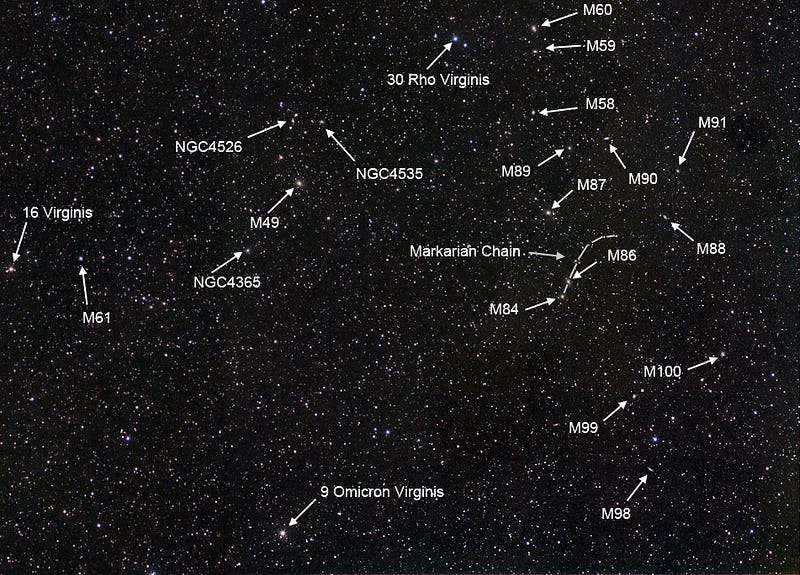
You see, there was a tremendous but subtle error in what Messier recorded!
The coordinates Messier gave for finding this were relative to Messier 58, a giant elliptical on the outskirts of the Virgo cluster, but there was nothing to be found in that position. Instead, he must have meant relative to Messier 89, another giant elliptical but one located just two degrees away from today’s object. Based on that assumption, M91 is clear and easy to find. The resolution of this error wasn’t discovered until 1969, when amateur astronomer William C. Williams figured it out!
Through a larger telescope, this object can be extremely rewarding.

There’s a large central bar, and long photographic exposures can bring out the faint features of spiral arms trailing off of it. For a time, it was speculated that this galaxy might not be a member of the Virgo cluster due to a number of factors:
- It’s anemic, which, in astronomy, means that it’s got a very low star-formation rate and a lower-than-expected presence of gas and dust,
- Its surface brightness is lower than one would expect, and
- It’s not receding from us at the typical 1,100 km/s that most Virgo galaxies are; it’s much slower at just 400-and-change km/s!
But these could simply be properties of this galaxy; they’re not typical, but since when do you expect one particular object to truly represent what we think of as “normal” for its class?

The answer is almost never. The oldest and most reliable way to measure distances to galaxies — by measuring Cepheid variable stars — places it at around 52-to-58 million light years distant (with some substantial uncertainty): perfectly consistent at being within the Virgo cluster. In addition, anemic galaxies are more common in large clusters, as their gas can be stripped away over time by rocketing through the intracluster medium at large velocities, which is exactly what Messier 91 appears to be doing!
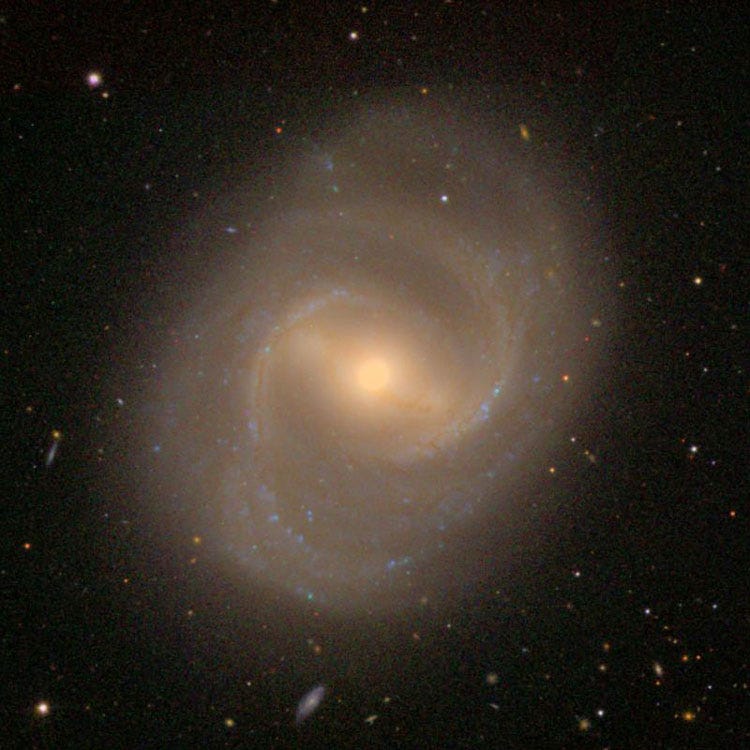
The whitish-yellow stars in its central bulge happen to be about 5 billion years old, or around the age of our Sun. This isn’t so surprising, but what is a surprise is just how enriched it is! We think of our Sun as being particularly full of heavy elements like iron, carbon, magnesium and so on.
But when we look at Messier 91, at its population of stars the same age as ours, we find that it has about four times as much iron-to-hydrogen [Fe/H] as our Sun does, something that’s extremely rare in the Universe! This could best be explained not by the gas-stripping that was mentioned earlier, which would have a very minuscule effect, but if Messier 91 formed more generations of stars faster than our own galaxy did, something that’s eminently plausible in a violent, dense cluster of galaxies like Virgo!
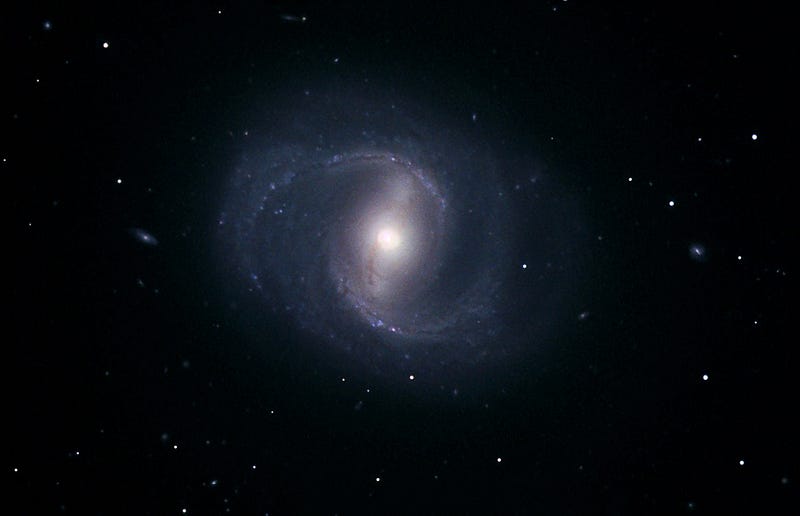
The best image of this galaxy — sorry Hubble — comes from NOAO, which puts the bulge, bar and arms prominently on display, along with a number of smaller and fainter background galaxies, many of which are in the Virgo cluster, too!
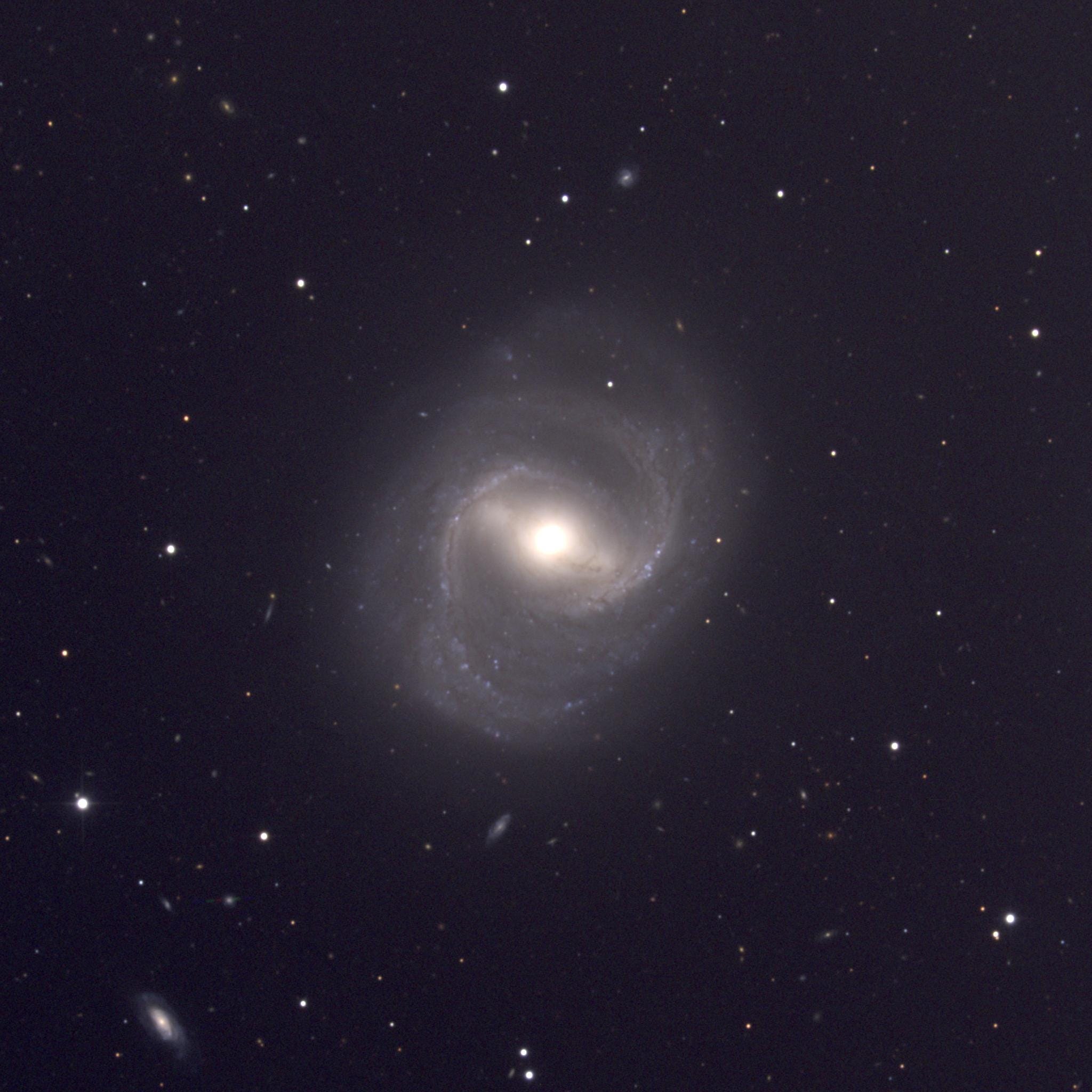
So that’s Messier 91, the faintest object in the entire catalogue, nearly as large as our Milky Way at 80,000 light-years in diameter from 52 million light-years away! That brings us to the end of another Messier Monday; including today’s object, we’ve looked at the following catalogue entries:
- M1, The Crab Nebula: October 22, 2012
- M2, Messier’s First Globular Cluster: June 17, 2013
- M3, Messier’s First Original Discovery: February 17, 2014
- M4, A Cinco de Mayo Special: May 5, 2014
- M5, A Hyper-Smooth Globular Cluster: May 20, 2013
- M7, The Most Southerly Messier Object: July 8, 2013
- M8, The Lagoon Nebula: November 5, 2012
- M10, A Perfect Ten on the Celestial Equator: May 12, 2014
- M11, The Wild Duck Cluster: September 9, 2013
- M12, The Top-Heavy Gumball Globular: August 26, 2013
- M13, The Great Globular Cluster in Hercules: December 31, 2012
- M14, The Overlooked Globular: June 9, 2014
- M15, An Ancient Globular Cluster: November 12, 2012
- M18, A Well-Hidden, Young Star Cluster: August 5, 2013
- M20, The Youngest Star-Forming Region, The Trifid Nebula: May 6, 2013
- M21, A Baby Open Cluster in the Galactic Plane: June 24, 2013
- M25, A Dusty Open Cluster for Everyone: April 8, 2013
- M29, A Young Open Cluster in the Summer Triangle: June 3, 2013
- M30, A Straggling Globular Cluster: November 26, 2012
- M31, Andromeda, the Object that Opened Up the Universe: September 2, 2013
- M32, The Smallest Messier Galaxy: November 4, 2013
- M33, The Triangulum Galaxy: February 25, 2013
- M34, A Bright, Close Delight of the Winter Skies: October 14, 2013
- M36, A High-Flying Cluster in the Winter Skies: November 18, 2013
- M37, A Rich Open Star Cluster: December 3, 2012
- M38, A Real-Life Pi-in-the-Sky Cluster: April 29, 2013
- M39, The Closest Messier Original: November 11, 2013
- M40, Messier’s Greatest Mistake: April 1, 2013
- M41, The Dog Star’s Secret Neighbor: January 7, 2013
- M42, The Great Orion Nebula: February 3, 2014
- M44, The Beehive Cluster / Praesepe: December 24, 2012
- M45, The Pleiades: October 29, 2012
- M46, The ‘Little Sister’ Cluster: December 23, 2013
- M47, A Big, Blue, Bright Baby Cluster: December 16, 2013
- M48, A Lost-and-Found Star Cluster: February 11, 2013
- M49, Virgo’s Brightest Galaxy: March 3, 2014
- M50, Brilliant Stars for a Winter’s Night: December 2, 2013
- M51, The Whirlpool Galaxy: April 15th, 2013
- M52, A Star Cluster on the Bubble: March 4, 2013
- M53, The Most Northern Galactic Globular: February 18, 2013
- M56, The Methuselah of Messier Objects: August 12, 2013
- M57, The Ring Nebula: July 1, 2013
- M58, The Farthest Messier Object (for now): April 7, 2014
- M59, An Elliptical Rotating Wrongly: April 28, 2014
- M60, The Gateway Galaxy to Virgo: February 4, 2013
- M61, A Star-Forming Spiral: April 14, 2014
- M63, The Sunflower Galaxy: January 6, 2014
- M64, The Black Eye Galaxy: February 24, 2014
- M65, The First Messier Supernova of 2013: March 25, 2013
- M66, The King of the Leo Triplet: January 27, 2014
- M67, Messier’s Oldest Open Cluster: January 14, 2013
- M68, The Wrong-Way Globular Cluster: March 17, 2014
- M71, A Very Unusual Globular Cluster: July 15, 2013
- M72, A Diffuse, Distant Globular at the End-of-the-Marathon: March 18, 2013
- M73, A Four-Star Controversy Resolved: October 21, 2013
- M74, The Phantom Galaxy at the Beginning-of-the-Marathon: March 11, 2013
- M75, The Most Concentrated Messier Globular: September 23, 2013
- M77, A Secretly Active Spiral Galaxy: October 7, 2013
- M78, A Reflection Nebula: December 10, 2012
- M79, A Cluster Beyond Our Galaxy: November 25, 2013
- M81, Bode’s Galaxy: November 19, 2012
- M82, The Cigar Galaxy: May 13, 2013
- M83, The Southern Pinwheel Galaxy, January 21, 2013
- M84, The Galaxy at the Head-of-the-Chain, May 26, 2014
- M85, The Most Northern Member of the Virgo Cluster, February 10, 2014
- M86, The Most Blueshifted Messier Object, June 10, 2013
- M87, The Biggest One of them All, March 31, 2014
- M88, A Perfectly Calm Spiral in a Gravitational Storm, March 24, 2014
- M90, The Better-You-Look, The Better-It-Gets Galaxy, May 19, 2014
- M91, A Spectacular Solstice Spiral, June 16, 2014
- M92, The Second Greatest Globular in Hercules, April 22, 2013
- M93, Messier’s Last Original Open Cluster, January 13, 2014
- M94, A double-ringed mystery galaxy, August 19, 2013
- M95, A Barred Spiral Eye Gazing At Us, January 20, 2014
- M96, A Galactic Highlight to Ring in the New Year, December 30, 2013
- M97, The Owl Nebula, January 28, 2013
- M98, A Spiral Sliver Headed Our Way, March 10, 2014
- M99, The Great Pinwheel of Virgo, July 29, 2013
- M101, The Pinwheel Galaxy, October 28, 2013
- M102, A Great Galactic Controversy: December 17, 2012
- M103, The Last ‘Original’ Object: September 16, 2013
- M104, The Sombrero Galaxy: May 27, 2013
- M105, A Most Unusual Elliptical: April 21, 2014
- M106, A Spiral with an Active Black Hole: December 9, 2013
- M107, The Globular that Almost Didn’t Make it: June 2, 2014
- M108, A Galactic Sliver in the Big Dipper: July 22, 2013
- M109, The Farthest Messier Spiral: September 30, 2013
Join us next week for an incredibly rare nebula adorning the summer skies, and another Messier Monday!
Enjoyed this? Comment on the Starts With A Bang forum at Scienceblogs!





